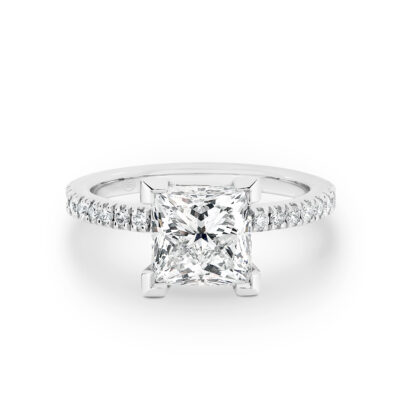Princess Cut Engagement Rings
The princess cut diamond is the second most popular shape of diamond for engagement rings after the round brilliant cut. We’ve provided some guidance below to help you decide whether a princess cut diamond is the right option for you, and you may also wish to read our general guidance on diamond grading.

The square modified brilliant cut
In terms of the major diamond shapes, the princess cut is a relatively new innovation, with several variations developed by different cutters since the 1960s. The technical name for a princess cut is ‘square modified brilliant’. It combines the stepped faceting seen in emerald cuts and Asscher cuts with the triangular facets of a brilliant cut. Unlike the emerald cut and Asscher cut it has right angled corners and as a brilliant cut it offers more sparkle than either of these.
More Diamond For Your Money

Most rough diamonds are broadly octahedral in shape, which makes cutting a square shaped diamond like a princess cut less wasteful than other shapes. A cutter would be doing well if he retains 50% of the rough weight in a round brilliant cut, while 80% would not be unusual for a princess cut. This lower wastage means that you get a larger polished diamond for your money.
Look Out For Colour In The Corners
Princess cuts tend to show colour quite strongly in their corners, putting more of a premium on the higher colour grades. H colour is a reasonable lower cut off if you want a white diamond, though ideally you would focus on diamonds graded G or better if your budget will allow it.
Eye-Clean Down To VS2
If a princess cut diamond has been graded by one of the more reputable gemological laboratories, such as The Gemological Institute of America (GIA), you can afford to be relatively lenient with the clarity grades that you will consider. The sparkle from the brilliant faceting helps to obscure small inclusions, so that anything down to VS2 should be flawless to the naked eye.
No Consensus On The Ideal Proportions
Not all princess cut diamonds are perfectly square, so it is worth checking to see how close the length and width of the diamond are. There is no consensus within the industry as to the ideal proportions for a princess cut, so a GIA-certified princess will not have a ‘cut’ grade listed on its certificate. The certificate will list a grade for polish and a grade for symmetry, but by themselves these are not enough to tell you how well the diamond will sparkle. There are a couple of other clues on the certificate. Firstly, you should check that the total depth is between 68% and 75%, as stones that are exceptionally deep or shallow are likely to ‘leak’ light out of the pavilion, and won’t return light as well as they should. The other factor you can check is the Table Width, which should be between 70% and 75%. A diamond with a really wide or really narrow table is unlikely to perform well.These two checks are indicators only that will enable you to weed out obviously unsuitable stones.
Please feel free to get in touch if you have any questions, or to discuss commissioning your own bespoke design.